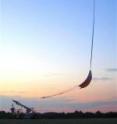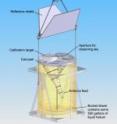Astronomers discover new radio signal using large balloon
A team of NASA-funded scientists, including two from UC Santa Barbara, have discovered cosmic radio noise that they find completely unexpected and exciting. The finding came from data collected from a large helium-filled NASA balloon, big enough to fit a football field inside. The scientists discovered cosmic radio noise that is blasting six times louder than expected.
"It seems as though we live in a darkened room and every time we turn the lights on and explore, we find something new," said team member Philip M. Lubin, professor of physics at UCSB. "The universe continues to amaze us and provide us with new mysteries. It is like a large puzzle that we are slowly given pieces to so that we can eventually see through the fog of our confusion."
The findings will be presented today at the 213th meeting of the American Astronomical Society in Long Beach, Calif. The mission, named ARCADE, was to search the sky for heat from the first generation of stars. Instead, it found a cosmic puzzle.
A mysterious screen of extra-loud radio noise permeates the cosmos, preventing astronomers from observing heat from the first stars. The balloon-borne ARCADE instrument discovered this cosmic static on its July 2006 flight. The noise is six times louder than expected. Astronomers have no idea why.
"The universe really threw us a curve," says team leader Alan Kogut team leader from NASA's Goddard Space Flight Center. "Instead of the faint signal we hoped to find, here was this booming noise six times louder than anyone had predicted." Detailed analysis ruled out an origin of primordial stars or known radio sources, including gas in the outermost halo of our own galaxy. The source of this cosmic radio background remains a mystery.
ARCADE stands for the Absolute Radiometer for Cosmology, Astrophysics, and Diffuse Emission. The instrument launched from NASA's Columbia Scientific Balloon Facility in Palestine, Tex., and flew to an altitude of 120,000 feet, where the atmosphere thins into the vacuum of space.
The problem, notes team member Dale Fixsen of the University of Maryland, is that there don't appear to be enough radio galaxies to account for the signal ARCADE detected. "You'd have to pack them into the universe like sardines," he said. "There wouldn't be any space left between one galaxy and the next."
The radio static ARCADE detected is much brighter than the combined radio emission of all of the galaxies in the universe. This suggests something new and interesting must have occurred as galaxies first formed, when the universe was less than half its current age.
Many objects in the universe emit radio waves. In 1931, American physicist Karl Jansky first detected radio static from our own Milky Way galaxy. Similar emissions from other galaxies create a background hiss of radio noise.
ARCADE is the first instrument to measure the radio sky with enough precision to detect this mysterious signal. To enhance the sensitivity of ARCADE's radio receivers, they were immersed in more than 500 gallons of ultra-cold liquid helium. The instrument's operating temperature was just 2.7 degrees above absolute zero.
Source: University of California - Santa Barbara
Articles on the same topic
- NASA balloon mission tunes in to a cosmic radio mysteryWed, 7 Jan 2009, 22:28:44 UTC


